As an Amazon Associate I earn from qualifying purchases.
Rich, tender braised duck bathed in comforting flavors: sauerkraut, root vegetables, even a little sausage. For duck or goose legs, braising is the way to go. It’s an easy weekend supper.
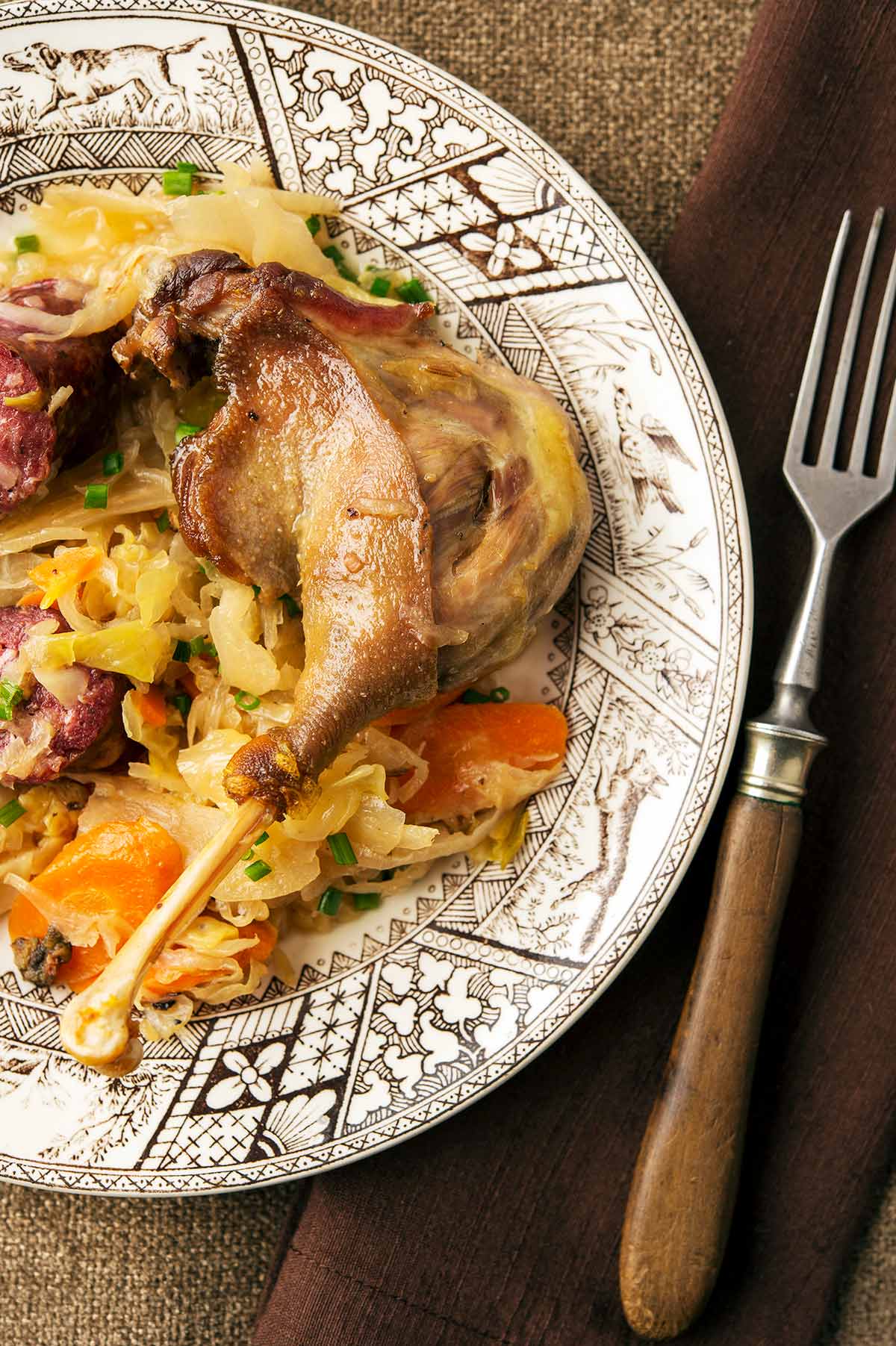
Pretty much every culture that eats duck makes braised duck, and this is a venerable recipe from Germany called braised duck Niederwald. It seems like ages since I first wrote about this recipe, and it has been — at least in blogging time. I first posted a version of this braised duck back in early 2008, and it was so popular it even got written up in Field & Stream. But time marches on, and now I look back at that original recipe and cringe.
This is the upgrade. It is basically the same German braised Duck Niederwald that I first found in the pages of the The Derrydale Game Cookbook (which, incidentally, was designed by my sister!), only streamlined, improved and generally made better than the old version.
At it’s core, this is a German pot roast, made with duck or goose legs. It has all the familiar German ingredients: sausage, sauerkraut, cabbage, caraway, onions, juniper.
It is uncomplicated and homey, and it cries out for German bread or potatoes and either a wiezenbock, Maibock or even a hearty doppelbock like Spaten Optimator, which is what I drank when I ate this last version. You could of course drink a nice dry Austrian Riesling, too.
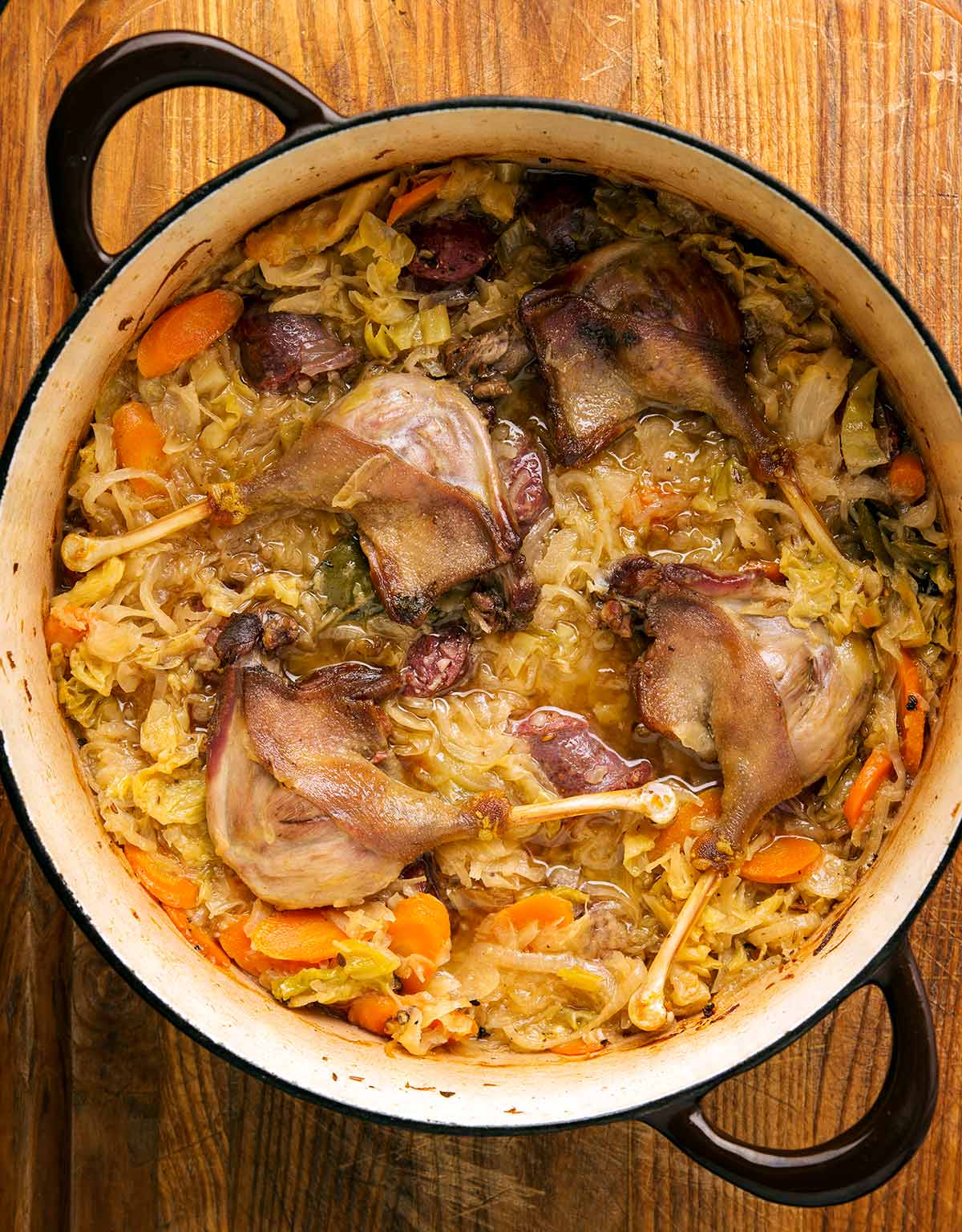
Why Make Braised Duck?
Braising tough parts of any animal is the best way to enjoy them: They remain whole, more or less, but are cooked slow and low in a broth until meltingly tender. The only thing braised duck, or really any braise, asks of you is time. You need a few hours to make this recipe.
Unless you decide to pressure cook the duck legs, in which case you can make this braised duck via Instant Pot in less than an hour. After the sauté steps, put the duck in with everything except the smoked sausage and set it to manual high pressure for 25 to 30 minutes — 30 minutes is best for wild duck. Let it naturally release pressure.
You can also braise duck in a slow cooker. Again, after the sauté steps, put everything in a slow cooker on high for about 6 to 8 hours. This way, you could get your braised duck going before work and it will be ready when you come home. Don’t worry if it cooks an extra hour or two; this recipe is forgiving.
Crispy Skin Trick
If you cook this recipe traditionally, in a lidded pot, and keep the browned duck skin up out of the braising liquid, it will stay pretty crispy. But if you want to take things to another level of crispiness, cook this braise in a 300°F oven until the meat is tender, then jack up the heat to 400°F and remove the lid for the last 15 minutes to get the skin extra crispy.
One thing that fascinates me with this recipe is the name: Niederwald. I know it happens to be a small town near Frankfurt in Germany, but beyond that I can find absolutely no reference to this dish other than the one in the Derrydale book. (And it doesn’t help that all I can think about when I say the name is Dean Wormer talking about Douglas Niedermeyer in “Animal House”… )
I have some other braised duck recipes, such as braised duck with leeks, and Peruvian ceviche de pato, which is braised legs with a chile and citrus sauce.
German Braised Duck Niederwald
Ingredients
- 2 to 3 pounds duck or goose legs and/or wings
- 2 tablespoons duck fat, lard or vegetable oil
- 3 cups shredded cabbage
- 1 small onion, sliced thin from root to tip
- 3 medium carrots, sliced thin
- 1 28 ounce jar of sauerkraut
- 1 cup white wine (Riesling would be good)
- 1 cup chicken, duck or other stock
- 2 bay leaves
- 3 cloves
- 1 teaspoon coarsely cracked black pepper
- 10 juniper berries, mashed but whole
- 1 teaspoon caraway seeds
- 2 smoked sausages, such as kielbasa or red bratwurst
- Salt
- Freshly chopped chives for garnish
Instructions
- Heat the duck fat in a large, lidded pot like a Dutch oven set over medium-high heat. Brown the duck or goose legs well, especially on the skin side. Salt the legs as they are cooking. Once each leg browns well, remove it to a plate for now. The whole process may take 10 to 15 minutes.
- When the duck has all been browned, add the onion, cabbage and carrot and sauté until the vegetables get just a little browning on the edges, about 3 to 5 minutes. Add the sauerkraut, wine, stock, herbs and spices. (Leave out the sausages for now.)
- Nestle the duck or goose legs into the kraut mixture and baste with a little of the liquid. Cover the pot and simmer very gently over low heat until the meat yields easily to the tip of a knife. How long? Anywhere from about 90 minutes for store-bought ducks to 3 1/2 hours for an old goose.
- About 15 minutes before you think the goose or duck legs will be done -- you need not be precise, as the legs are pretty forgiving in terms of overcooking them -- slice the sausages and nestle them into the pot, too. Cover and heat through. You don't want to cook the sausages too long or all the fat will drain out and they will be dry and unpleasant.
- When you're ready to serve, add salt to taste and sprinkle the chives over the dish. Serve with good rye bread, potatoes in some form (mashed, boiled, roasted, etc) or with dumplings. I particularly like the bread dumplings in my venison roast recipe.
Notes
Nutrition
Nutrition information is automatically calculated, so should only be used as an approximation.

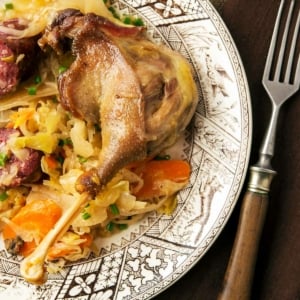
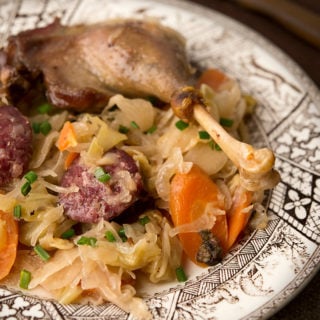

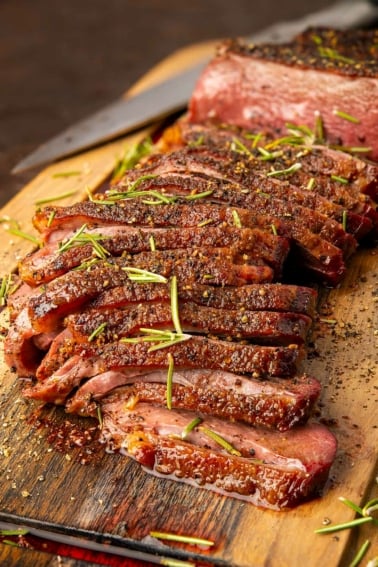
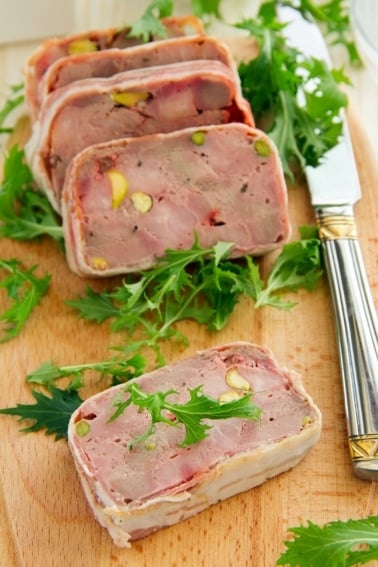

I have made this multiple times, always with legs from Canada geese. It was my Thanksgiving meal during COVID in 2020. Great recipe
Could this recipe be done with whole teal? I have five teal and our oven is acting up, but the stove is working fine. Also, I recently inquired about gumbo and coots and was amazed at your quick response; the gumbo was incredible. Everyone, including my 2 and 4 year-olds wanted more. My father even asked for a big bowl to take to work to show off to his buddies.
Thanks for all the help and recipes.
Robert: Yes, this would work with whole teal. Glad you liked the gumbo.
This is a fantastic recipe! I have been torturing myself on a low carb diet for the last 16 months, so a true comfort food is few and far between. I can only imagine what this is like when served with potatoes or dumplings as suggested.
I didn’t have the opportunity to use duck that I harvested myself but luckily the local grocer had some quality cuts. Duck fat is something I don’t have on-hand but grape seed oil was a worthy substitute. With it’s high smoking point I was able to give a good sear on the duck quarters bringing them to a beautiful golden brown. I added generous amount of kosher salt and course ground pepper to the duck as it seared. If I was to add no other ingredients to the dish I think I would still be more than satisfied…duck is damn good.
Most of my experience with cabbage growing up was store bought sauerkraut and sadly, coleslaw made by a national fried chicken chain…it’s no wonder I’ve never thought of it as the star of a dish. Homemade kraut is nothing like store bought and is extremely easy to make. Why haven’t I been doing this for years?
Cooked cabbage can have such a wonderful, crunchy texture and adding homemade sauerkraut gives it a much needed boost of acid. The result is a crisp and tangy, yet mellow kraut that compliments the rich and fatty duck perfectly. The duck and cabbage don’t battle each other for star billing. Each component compliments each other so well that it’s like listening to a beautiful duet. The juniper berries add just enough ‘forest’ essence to remind you of a camp cookout and the caraway gives hints or rye to satisfy my craving for fresh rustic bread.
I tried to keep to the original recipe as closely as possible given the ingredients I had available. As mentioned above I did swap the duck fat for grape seed oil. I didn’t have a white wine that I wanted to use but a Washington state Rosé worked quite well. My only other addition was a sprig of thyme as the duck braised in the oven…it’s still growing despite winter!
To finish I uncovered the the roasting pan and increased the temp from the suggested 300 degrees to a 500 degree broil for approx 8-10 minutes until the kraut tips started to brown and the sausages had good color on them.
For those in the family still ‘carbing’ it up I served the dish on a bed of garlic mashed potatoes to rave reviews. This recipe will have a permanent place and regular rotation in my arsenal. I can’t see any reason why this recipe wouldn’t work just as well with any cut of dark meat poultry whether harvested in the field or store bought…it’s really that good. ”
Thank you Hank for sharing your passions and culinary experiences. I look forward to diving in to all of your recipes.
Next up for me…Landjaeger!
Hank,
We made your recipe above with a slight modification/substitution. In place of duck, put in 2 pounds of smoked Canada Goose (2 legs and 1 breast). The meat had been smoked for hours the day prior with apple wood so we skipped the braising of the meat, adding it in after browning the veggies in step #2. Your mention of the tastiness of bird legs has me saving them on pheasant, duck and goose. All worked out great and we will be making this one again, maybe with smoked pheasant next. Thanks for your guidance and inspiration on how to prepare game; great to add a continental touch.
I made your recipe, using pheasant that I’d been gifted. It was marvelous! I am of German heritage – first generation American. I teach cooking and spend much time in Germany. Niederwald translates as lower forest, and the combination of wild game/birds with kraut or kohl of any kind is most certainly German and authentic. It could be that the recipe is a peasant recipe from any “lower forest” area or that it is from the Hessen region. In any case, it is a delicious combination. Thanks!
Hi there Hank!
I’m making this today, and it already smells awesome in our home. We moved to Hamburg, Germany (from South Africa) over a year ago and the game selection here is just great.
Having not had anything close to the incredible choice here I have looked to your site to get inspiration. Its been well worth while, many thanks.
I made the Hasenpfeffer recently to great applause from a german audience!
Thanks again for all the inspiring recipes.
XX Gizelle from Hamburg
I can vouch for red cabbage as they make it in Bavaria to go with your duck legs, it goes with a lot of dishes.
Use a whole head, leftover is getting better each time it is warmed up.
Bavarian Folklore said it is at it’s peak flavour wise after the 7 th warm-up.
A dish of braised meat with sauerkraut can rightly be labeled as Pan-Germanic, although your presentation in a lighter style clearly points to Alsace. Pairing with beer is a good choice generally, but a balanced wine from the region, perhaps a selection from Trimbach or Zind Humbrecht, compliments the richness of goose or duck in a way not possible with beer. The apparent sweetness of these wines are actually a reflection of ripeness, and always balanced with refreshing acidity. Just as Sauternes, a decidedly sweet wine, is the traditional pairing with cassoulet, a ripe and balanced riesling would make the goose braise shine. Riesling is not native to Austria, and Austrian wines are naturally more austere. Perhaps better paited with veal or rabbit. Cheers!
It’s a classic in this house. Delicious, thanks for the reminder
You’ll likely find that this is actually an old Alsace Lorraine recipe (German depending on which war you are looking at the map after!) My mother would sometimes fix duck very similar to this recipe — yes, Alsace Lorraine heritage.
Thank you for posting it.
Bon Appetit!
Dear Hank,
I didn’t mean to offend you at all! I know Germany is a biiig place, and there’s a million recipes I never heard of. Just, it definitely ain’t no classic.
And, I really don’t wish to take it up with mimi sheraton, but, as a matter of fact, “eingemacht” means “preserved, canned, pickled”! Try any translation sites, they’re with me. And, it’s a dish you can buy ready made, frozen, as fast-food, microwavable, just with chicken, not with rabbit. Definetly no revolution. Well, I suppose it doesn’t matter in a german cookbook made for americans:) Certainly don’t have a personal problem with it!
If you want any originally german family-recipes let me know. My granny makes a rabbit do die for. (She’s a war- child, they still ate rabbits!). And red cabbage german style is a fab side for duck and goose! And, I’m a fine cook. regards.
Dear Hank,
I’m afraid this is not a classical german recipe. I am german, and I never heard of anything alike. A classical german Duck is usually roasted in the oven, the whole bird, and served with red cabbage, seasoned with cloves, cinnamon, bay leaves, sugar and vinegar, and dumplings. It’s definitely a winter recipe.
Besides, your german rabbit is a classic, nowadays mainly made with chicken as many paople don’t eat rabbit and it’s not easy to get, it’s called “Kaninchen- Frikassee”. It’s definitely not called “eingemachtes Kaninchen” as that means “preserved rabbit”. And it’s not a bavarian recipe, too. Frikassee is an all german recipe, not regional. Sorry for being so critical.
I just discovered your blog today and I like it!
Miriam: Sorry, but you need to realize that Germany is a big place. Just because you haven’t heard if it doesn’t mean it isn’t a real recipe. The braised duck is from a German recipe from the 1800s translated, so I am not sure how much more German you can get. And the rabbit recipe’s name is directly from the most revered German cookbook written in the English language, so if you have a problem with it, take it up with the author, Mimi Sheraton.
Craig: But of course! Any root vegetable will do.
Hank,
Do you think turnips instead of the carrots would work? I have some turnips I would like to use up, and it sounds like it might be good.
Thanks!
Craig
Hank, I made your German Braised Duck the other evening – fabulous! My wife said it was one of the very few dishes that taste as good as they smelled while cooking.
Thank you!
Bernard
Jamie: It might, but remember that beaver is a strong red meat, stronger than goose even. I’d soak a hind leg in brine overnight, then try it. Might work fine.
hank,
how do you suppose this recipe would work with beaver?
As it happens, I made this recipe last weekend for a group of friends. I used goose legs and thighs, and it was phenomenal. Several non-game eating friends had seconds.
I used homemade sauerkraut, and used leeks in place of onions. This one goes in the favorite recipe file.
Hi Hank,
I lived in Germany for 5 years, and it seemed that each little town and village had a special beer / wine / dish associated with its history. Quite remarkable. This dish may have gone by 10 different names in Germany, this one being more popular – as I heard about it during a visit to Stuttgart. On a smaller note, it’s “Frankfurt” not Frankfort. Great recipe.
I don’t think I can help you with the origins. Niederwald means “lower forest”. Google maps doesn’t spit out a town in Germany, but there is a 1871 unification memorial. Still, I would guess it is some local forest or probably a persons name that came to the US.
A lot of “German American” dishes are a little uncanny to me. I think they pretty much branched off 100 years ago. All I can say your recipe feels southern German. But the ingredients are pretty generic (a not-upper class 19th century family’s Sunday meal? [*1]), just the side (dumplings for instance) would locate this further.
May I suggest red cabbage (Rotkraut, Blaukraut) instead of Sauerkraut? It is a bit sweeter (of course you have already stretched your Sauerkraut with unsoured cabbage) and I think might fit better with duck. But maybe that is a regional thing and some people don’t like the color.
[*1] Our family has a hand written recipe book of an ancestor that was maid/cook and these recipes were quite elaborate. I also think my grandma cooked similar to your recipe. But from my recent visits it is harder to find these kind of cooking in restaurants. Not sure what people cook at home these days.